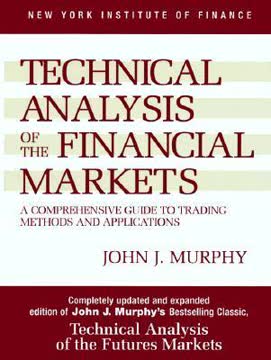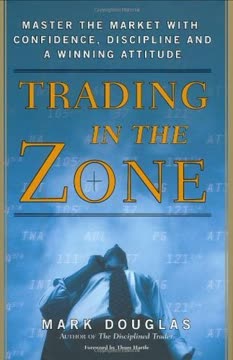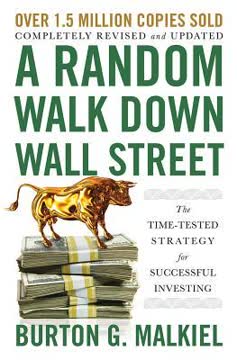Key Takeaways
1. Master Your Psychology: Emotions Are the Enemy of Successful Trading
"Nobody can get high and make money at the same time."
Control your emotions. The market is an unforgiving environment where emotional decisions lead to financial ruin. Successful traders approach the market with a calm, rational mindset, focusing on their trading plan rather than the emotional highs of winning or the lows of losing.
Recognize psychological traps. Common pitfalls include:
- The "brain myth": believing successful traders have secret knowledge
- The "autopilot myth": relying solely on automated systems
- The "undercapitalization myth": blaming losses on insufficient funds
Develop mental discipline. Treat trading like a serious business, not a game or entertainment. Implement strategies to manage stress, such as:
- Keeping a trading journal to track decisions and emotions
- Setting clear rules for entries, exits, and risk management
- Regularly reviewing and learning from both wins and losses
2. Understand Market Psychology: Trends Reflect Mass Behavior
"Markets are not moved by facts, but by the way crowds perceive and react to facts."
Markets mirror human behavior. Prices reflect the collective decisions of all market participants, driven by their emotions, beliefs, and reactions to information. Understanding this crowd psychology is crucial for successful trading.
Identify trend phases. Market trends typically follow a pattern:
- Accumulation: Knowledgeable investors start buying
- Public participation: The trend becomes obvious, attracting more buyers
- Distribution: Smart money begins to sell to late-comers
- Panic: The trend reverses, often sharply
Use indicators to gauge market sentiment. Tools like the New High-New Low Index, MACD-Histogram, and Stochastic can help you:
- Confirm the strength of trends
- Identify potential reversals
- Gauge overbought and oversold conditions
3. Develop a Robust Trading System: Combine Technical Analysis with Risk Management
"A trading system must combine trend-following indicators with oscillators."
Build a comprehensive system. A successful trading approach integrates multiple elements:
- Technical analysis to identify trends and entry/exit points
- Fundamental analysis for long-term market context
- Risk management rules to protect capital
- Psychological preparation and discipline
Use multiple indicators. Combine trend-following indicators (e.g., moving averages, MACD) with oscillators (e.g., Stochastic, RSI) to:
- Confirm trends
- Identify potential reversals
- Filter out false signals
Implement strict risk management. Key principles include:
- Never risk more than 2% of your account on a single trade
- Use stop-loss orders to limit potential losses
- Take partial profits to lock in gains and reduce risk exposure
4. Use Multiple Timeframes: Apply the Triple Screen Trading System
"The Triple Screen trading system combines trend-following indicators with oscillators and analyzes markets in multiple timeframes."
Analyze markets in context. The Triple Screen system uses three "screens" to filter trades:
- Long-term trend (e.g., weekly chart): Determine overall market direction
- Intermediate trend (e.g., daily chart): Identify counter-trend moves for entry
- Short-term timing (e.g., intraday chart): Fine-tune entry points
Follow the major trend. Only take trades in the direction of the long-term trend:
- In uptrends, look for buying opportunities during short-term pullbacks
- In downtrends, seek shorting opportunities during short-term rallies
Use multiple indicators. Combine different types of indicators across timeframes:
- Trend-following indicators (e.g., MACD-Histogram) on weekly charts
- Oscillators (e.g., Force Index, Elder-ray) on daily charts
- Price action or momentum indicators for short-term timing
5. Leverage Key Technical Indicators: MACD, Stochastic, and Elder-ray
"Elder-ray helps you see the power of bulls and bears below the surface of the markets."
Master essential indicators. Focus on understanding and effectively using a core set of powerful technical tools:
MACD (Moving Average Convergence-Divergence):
- Identifies trends and potential reversals
- Provides buy/sell signals through line crossovers and divergences
Stochastic:
- Measures momentum and identifies overbought/oversold conditions
- Effective for trading range-bound markets
Elder-ray:
- Compares current prices to a moving average
- Reveals the relative strength of bulls and bears
Look for convergence. The strongest trading signals occur when multiple indicators align, confirming a potential move.
Pay attention to divergences. When price makes a new high/low but an indicator doesn't confirm, it often signals a potential reversal.
6. Implement Effective Money Management: Survival Comes First
"The first goal of money management is to ensure survival."
Prioritize capital preservation. Without capital, you can't trade. Key principles include:
- Never risk more than you can afford to lose
- Avoid overleveraging your account
- Use position sizing to manage risk across multiple trades
Set realistic goals. Aim for steady, consistent returns rather than trying to get rich quick:
- A 25-30% annual return is excellent performance
- Focus on building a solid track record over time
Use the 2% rule. Never risk more than 2% of your account equity on a single trade:
- This limits the impact of losing streaks
- Allows you to withstand multiple consecutive losses without blowing up your account
Manage winning trades. Protect profits and reduce risk exposure:
- Use trailing stops to lock in gains
- Take partial profits at predetermined levels
- Let winners run while managing risk
7. Continuously Learn and Adapt: Markets Change, So Should You
"Markets are forever changing, and the methods that worked yesterday are not likely to work today and even less likely to work a year from now."
Stay flexible. The only constant in markets is change. Successful traders:
- Regularly review and update their trading systems
- Adapt to changing market conditions and volatility
- Remain open to new ideas and techniques
Embrace continuous learning. Improve your skills and knowledge through:
- Studying market history and past trends
- Analyzing your own trades (both winners and losers)
- Staying informed about economic and geopolitical events
Test and refine your approach. Use backtesting and paper trading to:
- Validate new trading ideas before risking real money
- Optimize your system parameters
- Build confidence in your trading plan
Cultivate a growth mindset. View challenges and setbacks as opportunities to learn and improve:
- Analyze losing trades for valuable lessons
- Seek feedback from other traders or mentors
- Stay humble and acknowledge that there's always more to learn
Last updated:
FAQ
What's Trading for a Living by Alexander Elder about?
- Focus on Psychology: The book emphasizes the critical role of psychology in trading, highlighting how emotions like fear and greed can impact decision-making.
- Trading Tactics and Money Management: It offers practical trading tactics and money management strategies, essential for long-term success in the markets.
- Three Pillars of Trading: The book is structured around three main pillars: psychology, market analysis, and money management, each contributing to a trader's success.
Why should I read Trading for a Living by Alexander Elder?
- Expert Insights: Written by Dr. Alexander Elder, a psychiatrist and professional trader, the book combines psychological principles with trading strategies.
- Comprehensive Guide: It serves as a complete guide for both novice and experienced traders, offering insights into trading psychology, technical analysis, and risk management.
- Real-World Applications: Dr. Elder shares personal experiences and lessons learned, making the content relatable and applicable to real-world trading scenarios.
What are the key takeaways of Trading for a Living by Alexander Elder?
- Self-Discipline is Crucial: The book stresses the importance of self-discipline in managing emotions and adhering to trading plans.
- Understanding Market Psychology: Recognizing crowd behavior and mass psychology can help traders make informed decisions.
- Risk Management is Essential: Effective risk management is vital for long-term survival, as even the best strategies can fail without it.
How does Trading for a Living define trading psychology?
- Key to Success: Psychology is highlighted as the key to successful trading, with an emphasis on understanding one's own emotions and biases.
- Emotional Roller Coaster: Trading is described as an emotional roller coaster, where managing emotions is essential for maintaining discipline.
- Self-Analysis: Keeping a trading diary is encouraged to analyze decisions and emotional responses, helping identify patterns of behavior.
What is the Triple Screen Trading System in Trading for a Living?
- Three-Step Approach: It involves analyzing the market on three different timeframes to confirm trading signals, filtering out noise for reliable signals.
- Combining Indicators: The system uses a combination of trend-following indicators and oscillators to identify entry and exit points.
- Risk Management Focus: Emphasizes strict money management rules, ensuring traders do not risk more than a predetermined percentage of their capital.
What are the different types of gaps mentioned in Trading for a Living?
- Common Gaps: Occur in quiet markets and are quickly closed, often not significant for trading decisions.
- Breakaway Gaps: Signal the beginning of a new trend with increased volume, indicating a strong shift in market sentiment.
- Exhaustion Gaps: Occur at the end of a trend, signaling a potential reversal and providing excellent shorting opportunities.
How does Trading for a Living explain the concept of trendlines?
- Identifying Trends: Trendlines connect significant highs or lows on a chart, helping traders visualize market direction.
- Support and Resistance: They can act as support in uptrends and resistance in downtrends, providing critical levels for trading decisions.
- Angle of the Trendline: The slope indicates trend strength, with steeper lines suggesting stronger trends.
What are the best quotes from Trading for a Living by Alexander Elder and what do they mean?
- "The key to winning was inside my head and not inside a computer.": Emphasizes the importance of psychology over technical tools in trading.
- "You can have a brilliant trading system, but if your money management is bad, then a short string of losses will destroy your account.": Highlights the necessity of effective risk management.
- "Do not confuse brains with a bull market.": Cautions against overconfidence during market upswings, reminding traders to remain disciplined.
How can I apply the concepts from Trading for a Living to my trading strategy?
- Develop a Trading Plan: Create a detailed plan including entry and exit strategies, risk management rules, and psychological self-assessments.
- Monitor Market Psychology: Pay attention to crowd behavior and sentiment indicators to gauge market mood.
- Practice Risk Management: Implement strict money management rules to protect your account from significant losses.
How does the Triple Screen trading system work in Trading for a Living?
- Three Screens for Analysis: Analyzes trades through three timeframes: long-term trend, intermediate trend, and short-term price action.
- First Screen - Market Tide: Uses a trend-following indicator on a weekly chart to identify the primary trend.
- Second Screen - Market Wave: Applies oscillators to daily charts to find entry points against the tide.
What is the significance of emotional control in trading as discussed in Trading for a Living?
- Impact of Emotions: Emotions like fear and greed can cloud judgment, leading to poor trading decisions.
- Psychological Strategies: Offers strategies for developing emotional resilience, such as setting clear trading rules.
- Long-Term Success: Emotional control is key to achieving long-term success, helping traders follow strategies and avoid costly mistakes.
How can I improve my trading discipline as suggested in Trading for a Living?
- Set Clear Rules: Establish and adhere to clear trading rules, including entry and exit points, risk limits, and profit targets.
- Emotional Awareness: Recognize emotional triggers and their effects on trading decisions, practicing mindfulness and self-reflection.
- Regular Review: Conduct regular reviews of trading performance to identify areas for improvement and reinforce disciplined behavior.
Review Summary
Trading for a Living receives mostly positive reviews, with an average rating of 4.05/5. Readers praise its comprehensive coverage of trading psychology, tactics, and money management. Many find it valuable for both beginners and experienced traders. The book's strengths include its insights on market psychology, risk management, and technical analysis. Some criticize its outdated examples and repetitive writing style. Overall, readers appreciate Elder's straightforward approach and practical advice, considering it a must-read for aspiring traders.
Similar Books










Download PDF
Download EPUB
.epub digital book format is ideal for reading ebooks on phones, tablets, and e-readers.







